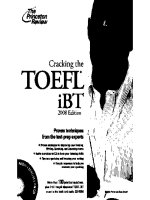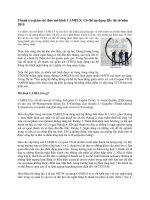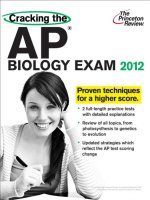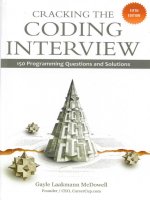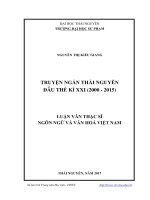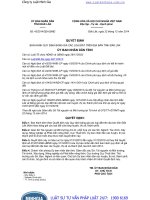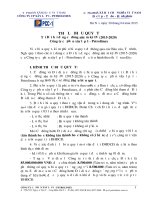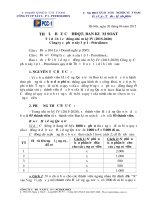Cracking the AP chemistry exam, 2015 edition (2015)
Bạn đang xem bản rút gọn của tài liệu. Xem và tải ngay bản đầy đủ của tài liệu tại đây (19.31 MB, 415 trang )
Editorial
Rob Franek, Senior VP, Publisher
Casey Cornelius, VP Content Development
Mary Beth Garrick, Director of Production
Selena Coppock, Managing Editor
Calvin Cato, Editor
Colleen Day, Editor
Aaron Riccio, Editor
Meave Shelton, Editor
Orion McBean, Editorial Assistant
Random House Publishing Team
Tom Russell, Publisher
Alison Stoltzfus, Publishing Manager
Melinda Ackell, Associate Managing Editor
Ellen Reed, Production Manager
Kristin Lindner, Production Supervisor
Andrea Lau, Designer
The Princeton Review, Inc.
24 Prime Parkway, Suite 201
Natick, MA 01760
E-mail:
Copyright © 2014 by TPR Education IP Holdings, LLC. All rights reserved.
Cover art © laboratory/Alamy
Published in the United States by Random House LLC, New York, and
simultaneously in Canada by Random House of Canada Limited, Toronto.
A Penguin Random House Company.
eBook ISBN: 978-0-8041-2513-0
Trade Paperback ISBN: 978-0-8041-2512-3
AP and Advanced Placement Program are registered trademarks of the
College Board, which does not sponsor or endorse this product.
The Princeton Review is not affiliated with Princeton University.
Editor: Calvin S. Cato
Production Editor: Jesse Newkirk
Production Artist: Deborah Silvestrini
2015 Edition
v3.1
Acknowledgments
Paul Foglino would like to thank John Katzman for his oversight on this project and Rebecca
Lessem for her work editing the first edition of this title. Thanks to Rachel Warren, whose
guidance and tireless effort helped to convert chemistry to English. Thanks to Eric Payne
for his rigorous attention to detail. Thanks to Tom Meltzer for his advice and Libby
O’Connor for her patience. Additional thanks are in order to Robbie Korin, James Karb, and
Chris Volpe.
The Princeton Review would like to give special thanks to Nicolas Leonardi for his hand in
revising and updating this title to better prepare students for the new AP Chemistry exam.
Contents
Cover
Title Page
Copyright
Acknowledgments
Part I: Using This Book to Improve Your AP Score
Preview Activity: Your Knowledge, Your Expectations
Your Guide to Using This Book
How to Begin
Part II: About the AP Chemistry Exam
The Structure of the AP Chemistry Exam
Overview of Content Topics
How AP Exams Are Used
Other Resources
Designing Your Study Plan
Part III: Test-Taking Strategies for the AP Chemistry Exam
1
2
How to Approach Multiple-Choice Questions
How to Approach Free-Response Questions
Part IV: Content Review for the AP Chemistry Exam
3
4
Big Idea #1: Atoms, Elements, and the Building Blocks of Matter
The Periodic Table
Moles
Coulomb’s Law
Photoelectron Spectroscopy
Periodic Trends
Chapter 3 Questions
Chapter 3 Answers and Explanations
Big Idea #2: Bonding and Phases
Bonds Overview
Ionic Bonds
Metallic Bonds
5
6
7
Covalent Bonds
Intermolecular Forces
Vapor Pressure
Lewis Dot Structures
Kinetic Molecular Theory
Maxwell-Boltzmann Diagrams
The Ideal Gas Equation
Dalton’s Law
Deviations from Ideal Behavior
Density
Solutions
Chapter 4 Questions
Chapter 4 Answers and Explanations
Big Idea #3: Chemical Reactions, Energy Changes, and Redox Reactions
Types of Reactions
Chemical Equations
Enthalpy
Energy Diagrams
Catalysts and Energy Diagrams
Oxidation States
Oxidation-Reduction Reactions
Galvanic Cells
Electrolytic Cells
Chapter 5 Questions
Chapter 5 Answers and Explanations
Big Idea #4: Chemical Reactions and Their Rates
Rate Law Using Initial Concentrations
Rate Law Using Concentration and Time
Collision Theory
Beer’s Law
Reaction Mechanisms
Catalysts
Chapter 6 Questions
Chapter 6 Answers and Explanations
Big Idea #5: Laws of Thermodynamics and Changes in Matter
Energy Transfer
First and Second Laws of Thermodynamics
State Functions
Heat of Formation, ∆H0 f
8
Bond Energy
Hess’s Law
Thermodynamics of Phase Change
Calorimetry
Entropy
Gibbs Free Energy
Free Energy Change, ∆G
∆G, ∆H, and ∆S
Voltage and Favorability
Chapter 7 Questions
Chapter 7 Answers and Explanations
Big Idea #6: Equilibrium, Acids and Bases, Titrations, and Solubility
The Equilibrium Constant, Keq
Le Châtelier’s Principle
Changes in the Equilibrium Constant
The Reaction Quotient, Q
Solubility
Acids and Bases Definitions
pH
Weak Acids
Strong Acids
Kw
9
Buffers
Polyprotic Acids and Amphoteric Substances
Titration
Chapter 8 Questions
Chapter 8 Answers and Explanations
Laboratory Overview
Part V: Practice Tests
10 Practice Test 1
11 Practice Test 1 Answers and Explanations
12 Practice Test 2
13 Practice Test 2 Answers and Explanations
About the Authors
Part I
Using This Book to Improve Your AP Score
PREVIEW ACTIVITY: YOUR KNOWLEDGE, YOUR
EXPECTATIONS
Your route to a high score on the AP Chemistry Exam depends a lot on how you plan to
use this book. Please respond to the following questions.
1. Rate your level of confidence about your knowledge of the content tested by
the Chemistry AP Exam:
A.
B.
C.
D.
Very confident—I know it all
I’m pretty confident, but there are topics for which I could use help
Not confident—I need quite a bit of support
I’m not sure
2. Circle your goal score for the AP Chemistry Exam.
3. What do you expect to learn from this book? Circle all that apply to you.
A.
B.
C.
D.
A general overview of the test and what to expect
Strategies for how to approach the test
The content tested by this exam
I’m not sure yet
YOUR GUIDE TO USING THIS BOOK
This book is organized to provide as much—or as little—support as you need, so you can
use this book in whatever way will be most helpful to improving your score on the AP
Chemistry Exam.
The remainder of Part I will provide guidance on how to use this book and help you
determine your strengths and weaknesses
Part II of this book will
provide information about the structure, scoring, and content of the
Chemistry Exam
help you to make a study plan
point you towards additional resources
Part III of this book will explore
how to attack multiple-choice questions
how to write high-scoring free-response answers
how to manage your time to maximize the number of points available to
you
Part IV of this book covers the content you need for your exam.
Part V of this book contains practice tests.
You may choose to use some parts of this book over others, or you may work through
the entire book. This will depend on your needs and how much time you have. Let’s now
look how to make this determination.
HOW TO BEGIN
1. Take a Test
Before you can decide how to use this book, you need to take a practice test. Doing
so will give you insight into your strengths and weaknesses, and the test will also
help you make an e ective study plan. If you’re feeling test-phobic, remind yourself
that a practice test is a tool for diagnosing yourself—it’s not how well you do that
matters but how you use information gleaned from your performance to guide your
preparation.
So, before you read further, take AP Chemistry Practice Test 1 starting at this page
of this book. Be sure to do so in one sitting, following the instructions that appear
before the test.
2. Check Your Answers
Using the answer key on this page, count how many multiple-choice questions you
got right and how many you missed. Don’t worry about the explanations for now,
and don’t worry about why you missed questions. We’ll get to that soon.
3. Reflect on the Test
After you take your first test, respond to the following questions:
How much time did you spend on the multiple-choice questions?
How much time did you spend on each long form free-response question? What
about each short form free-response question?
How many multiple-choice questions did you miss?
Do you feel you had the knowledge to address the subject matter of the freeresponse questions?
Do you feel you wrote well organized, thoughtful answers to the free-response
questions?
Circle the content areas that were most challenging for you and draw a line
through the ones in which you felt confident/did well.
Big Idea #1: Atoms, Elements, and the Building Blocks of Matter
Big Idea #2: Chemical and Physical Properties of Matter
Big Idea #3: Chemical Reactions, Energy Changes, and Redox Reactions
Big Idea #4: Chemical Reactions and their Rates
Big Idea #5: Laws of Thermodynamics and Changes in Matter
Big Idea #6: Equilibrium, Acids and Bases, Titrations and Solubility
4. Read Part II of this Book and Complete the Self-Evaluation
As discussed previously, Part II will provide information on how the test is
structured and scored. As you read Part II, re-evaluate your answers to the questions
on the previous page. You will then be able to make a study plan, based on your
needs and time available, that will allow you to use this book most effectively.
5. Engage with Parts III and IV as Needed
Notice the word engage. You’ll get more out of this book if you use it intentionally
than if you read it passively, hoping for an improved score through osmosis.
The strategy chapters will help you think about your approach to the question types
on this exam. Part III will open with a reminder to think about how you approach
questions now and then close with a re ection section asking you to think about
how/whether you will change your approach in the future.
The content chapters are designed to provide a review of the content tested on the
AP Chemistry Exam, including the level of detail you need to know and how the
content is tested. You will have the opportunity to assess your mastery of the
content of each chapter through test-appropriate questions.
6. Take Test 2 and Assess Your Performance
Once you feel you have developed the strategies you need and gained the
knowledge you lacked, you should take Test 2, which starts at this page of this
book. You should do so in one sitting, following the instructions at the beginning of
the test.
When you are done, check your answers to the multiple-choice sections. See if a
teacher will read your answers to the free-response questions and provide feedback.
Once you have taken the test, re ect on what areas you still need to work on, and
revisit the chapters in this book that address those de ciencies. Through this type of
reflection and engagement, you will continue to improve.
7. Keep Working
After you have revisited certain chapters in this book, continue the process of
testing, re ecting, and engaging with the second test. Each time, consider what
additional work you need to do and how you will change your strategic approach to
different parts of the test.
Part II
About the AP Chemistry Exam
THE STRUCTURE OF THE AP CHEMISTRY EXAM
The AP Chemistry Exam is a three-hour-long, two-section test that attempts to cover the
material you would learn in a college rst-year chemistry course. The rst section is a
90-minute 60-question multiple-choice section. The second section is also 90 minutes and
consists of 3 long-form free-response questions and 4 short-form free-response questions.
The multiple-choice section is scored by a computer, and the free-response questions are
scored by a committee of high school and college teachers. The free-response questions
are graded according to a standard set at the beginning of the grading period by the
chief faculty consultants. Inevitably, the grading of Section II is never as consistent or
accurate as the grading of Section I.
The AP Chemistry exam recently changed in May 2014, and as such there is no data on
the necessary raw score to get a 3, 4, or 5. The breakdown will not be decided until
after the exams have been scored, and with no past exams using this curriculum there is
no existing standard to judge yourself by. Just do your best!
OVERVIEW OF CONTENT TOPICS
The concepts of the AP Chemistry exam are broken down into six major themes de ned
by the College Board as the Big Ideas. Rather than learning multiple disparate topics (as
has been done in the past), these Big Ideas interconnect principles within these topics
that describe fundamental chemical phenomena. The six Big Ideas are as follows:
Big Idea #1: The chemical elements are fundamental building materials of matter,
and all matter can be understood in terms of arrangements of atoms. These atoms
retain their identity in chemical reactions.
Big Idea #2: Chemical and physical properties of materials can be explained by the
structure and the arrangement of atoms, ions, or molecules and the forces between
them.
Big Idea #3: Changes in matter involve the rearrangement and/or reorganization
of atoms and/or the transfer of electrons.
Big Idea #4: Rates of chemical reactions are determined by details of the molecular
collisions.
Big Idea #5: The laws of thermodynamics describe the essential role of energy and
explain and predict the direction of changes in matter.
Big Idea #6: Any bond or intermolecular attraction that can be formed can be
broken. These two processes are in a dynamic competition, sensitive to initial
conditions and external perturbations.
This book has been arranged to teach chemistry topics grouped to each of these Big
Ideas.
HOW AP EXAMS ARE USED
Di erent colleges use AP Exam scores in di erent ways, so it is important that you go to
a particular college’s web site to determine how it uses AP Exam scores. The three items
below represent the main ways in which AP Exam scores can be used.
College Credit. Some colleges will give you college credit if you score well on an
AP Exam. These credits count towards your graduation requirements, meaning that
you can take fewer courses while in college. Given the cost of college, this could be
quite a benefit, indeed.
Satisfy Requirements. Some colleges will allow you to “place out” of certain
requirements if you do well on an AP Exam, even if they do not give you actual
college credits. For example, you might not need to take an introductory-level
course, or perhaps you might not need to take a class in a certain discipline at all.
Admissions Plus. Even if your AP Exam will not result in college credit or even
allow you to place out of certain courses, most colleges will respect your decision to
push yourself by taking an AP Course or even an AP Exam outside of a course. A
high score on an AP Exam shows mastery of more di cult content than is taught in
many high school courses, and colleges may take that into account during the
admissions process.
OTHER RESOURCES
There are many resources available to help you improve your score on the AP Chemistry
Exam, not the least of which are your teachers. If you are taking an AP class, you may
be able to get extra attention from your teacher, such as obtaining feedback on your
free-response questions. If you are not in an AP course, reach out to a teacher who
teaches chemistry, and ask if the teacher will review your free-response questions or
otherwise help you with content.
Another wonderful resource is AP Central, the o cial site of the AP Exams. The scope
of the information at this site is quite broad and includes:
Course Description, which includes details on what content is covered and sample
questions
Sample questions relating to the new exam
Free-response question prompts and multiple-choice questions from previous years
The
AP
Central
home
page
/>
address
is:
For up-to-date information about the ongoing changes to the AP Chemistry Course,
please visit: />Finally, The Princeton Review o ers tutoring and small group instruction. Our expert
instructors can help you re ne your strategic approach and add to your content
knowledge. For more information, call 1-800-2REVIEW.
DESIGNING YOUR STUDY PLAN
As part of the Introduction, you identi ed some areas of potential improvement. Let’s
now delve further into your performance on Test 1, with the goal of developing a study
plan appropriate to your needs and time commitment.
Read the answers and explanations associated with the multiple-choice questions
(starting at this page). After you have done so, respond to the following questions:
Review the Overview of Content Topics at this page. Next to each topic, indicate
your rank of the topic as follows: “1” means “I need a lot of work on this,” “2”
means “I need to beef up my knowledge,” and “3” means “I know this topic well.”
How many days/weeks/months away is your exam?
What time of day is your best, most focused study time?
How much time per day/week/month will you devote to preparing for your exam?
When will you do this preparation? (Be as speci c as possible: Mondays &
Wednesdays from 3 to 4 pm, for example)
Based on the answers above, will you focus on strategy (Part III) or content (Part
IV) or both?
What are your overall goals in using this book?
Part III
Test-Taking Strategies for the AP Chemistry
Exam
Chapter 1
How to Approach Multiple-Choice Questions
THE BASICS
Section I of the test is composed of 60 multiple-choice questions, for which you are
allotted 90 minutes. This part is worth 50 percent of your total score.
For this section, you will be given a periodic table of the elements along with a sheet
that lists common chemistry formulas, and you may NOT use a calculator. The College
Board says that this is because the new scienti c calculators not only program and
graph but also store information—and they are afraid you’ll use this function to cheat!
On the multiple-choice section, you receive 1 point for a correct answer. There is no
penalty for leaving a question blank or getting a question wrong.
PACING
According to the College Board, the multiple-choice section of the AP Chemistry Exam
covers more material than any individual student is expected to know. Nobody is
expected to get a perfect or even near perfect score. What does that mean to you?
Use the Two-Pass System
Go through the multiple-choice section twice. The rst time, do all the questions that you
can get answers to immediately. That is, do the questions with little or no math and
questions on chemistry topics in which you are well versed. Skip questions on topics that
make you uncomfortable. Also, you want to skip the ones that look like number
crunchers (even without a calculator, you may still be expected to crunch a few
numbers). Circle the questions that you skip in your test booklet so you can nd them
easily during the second pass. Once you’ve done all the questions that come easily to
you, go back and pick out the tough ones that you have the best shot at.
In general, the questions near the end of the section are tougher than the questions near
the beginning. You should keep that in mind, but be aware that each person’s
experience will be di erent. If you can do acid-base questions in your sleep, but you’d
rather have your teeth drilled than draw a Lewis diagram, you may nd questions near
the end of the section easier than questions near the beginning.
That’s why the Two-Pass System is so handy. By using it, you make sure you get to see
all the questions you can get right, instead of running out of time because you got
bogged down on questions you couldn’t do earlier in the test.
Don’t Turn a Question into a Crusade!
Most people don’t run out of time on standardized tests because they work too slowly.
Instead, they run out of time because they spend half the test wrestling with two or
three particular questions.
You should never spend more than a minute or two on any question. If a question
doesn’t involve calculation, then either you know the answer, you can make an
educated guess, or you don’t know the answer. Figure out where you stand on a
question, make a decision, and move on.
Any question that requires more than two minutes worth of calculations probably isn’t
worth doing. Remember: Skipping a question early in the section is a good thing if it
means that you’ll have time to get two correct answers later on.
GUESSING
You get one point for every correct answer on the multiple-choice section. Guessing
randomly neither helps you nor hurts you. Educated guessing, however, will help you.
Use Process of Elimination (POE) to Find Wrong Answers
There is a fundamental weakness to a multiple-choice test. The test makers must show
you the right answer, along with three wrong answers. Sometimes seeing the right
answer is all you need. Other times you may not know the right answer, but you may be
able to identify one or two of the answers that are clearly wrong. Here is where you
should use process of elimination (POE) to take an educated guess.
Look at this hypothetical question.
1. Which of the following compounds will produce a purple solution when added to water?
(A) Brobogdium rabelide
(B) Diblythium perjuvenide
(C) Sodium chloride
(D) Carbon dioxide
You should have no idea what the correct answer is because two of these compounds are
made up, but you do know something about the obviously wrong answers. You know
that sodium chloride, choice (C), and carbon dioxide, choice (D), do not turn water
purple. So, using POE, you have a 50 percent chance at guessing the correct answer.
Now the odds are in your favor. Now you should guess.
Guess and Move On
Remember that you’re guessing. Pondering the possible di erences between brobogdium
rabelide and diblythium perjuvenide is a waste of time. Once you’ve taken POE as far as
it will go, pick your favorite letter and move on.
The multiple-choice section is the exact opposite of the free-response section. It’s scored
by a machine. There’s no partial credit. The computer doesn’t know, or care if you
know, why an answer is correct. All the computer cares about is whether you blackened
in the correct oval on your score sheet. You get the same number of points for picking
(B) because you know that (A) is wrong and that (B) is a nicer letter than (C) or (D) as
you would get for picking (B) because you fully understood the subtleties of an
electrochemical process.
ABOUT CALCULATORS
You will NOT be allowed to use a calculator on this section. That shouldn’t worry you.
All it means is that there won’t be any questions in the section that you’ll need a
calculator to solve.
Most of the calculation problems will have fairly user-friendly numbers—that is,
numbers with only a couple of signi cant digits, or things like “11.2 liters of gas at STP”
or “160 grams of oxygen” or “a temperature increase from 27°C to 127°C.” Sometimes
these user-friendly numbers will actually point you toward the proper steps to take in
your calculations.
Don’t be afraid to make rough estimates as you do your calculations. Sometimes
knowing that an answer is closer to 50 than to 500 will enable you to pick the correct
answer on a multiple-choice test (if the answer choices are far enough apart). Once
again, the rule against calculators works in your favor because the College Board will
not expect you to do very precise calculations by hand.
REFLECT
Respond to the following questions:
How long will you work on multiple-choice questions?
How will you change your approach to multiple-choice questions?
What is your multiple-choice guessing strategy?
Chapter 2
How to Approach Free-Response Questions
OVERVIEW OF THE FREE-RESPONSE SECTION
Section II is composed of 7 free-response questions. You will be given 90 minutes to
complete this section, which is worth 50 percent of your total score.
The rst three free-response questions are longer, and are worth 10 points each. The
College Board recommends you take about 20 minutes per question on these. The last
four questions are much shorter, and only worth 4 points each. For these, the College
Board recommends you take about 7 minutes each.
The suggested times are just that, suggestions-your results may vary based on how
comfortable you are with the topic being tested within each question. They do give you
a good guideline though. You probably shouldn’t be spending more than about 20
minutes on any of the rst three questions. Don’t be afraid to cut yourself o and come
back to questions later if time allows.
CRACKING THE MATH PROBLEMS
You want to show the graders that you can do chemistry math, so here are some
suggestions.
Show Every Step of Your Calculations on Paper
This section is the opposite of multiple choice. You don’t just get full credit for writing
the correct answer. You get most of your points on this section for showing the process
that got you to the answer. The graders give you partial credit when you show them that
you know what you’re doing. So even if you can do a calculation in your head, you
should set it up and show it on the page.
By showing every step, or explaining what you’re doing in words, you ensure that you’ll
get all the partial credit possible, even if you screw up a calculation.
Include Units in All Your Calculations
Scientists like units in calculations. Units make scientists feel secure. You’ll get points
for including them and you may lose points for leaving them out.
Remember Significant Figures
You can lose 1 point per question if your answer is o by more than one signi cant
gure. Without getting too bent out of shape about it, try to remember that a
calculation is only as accurate as the least accurate number in it.
